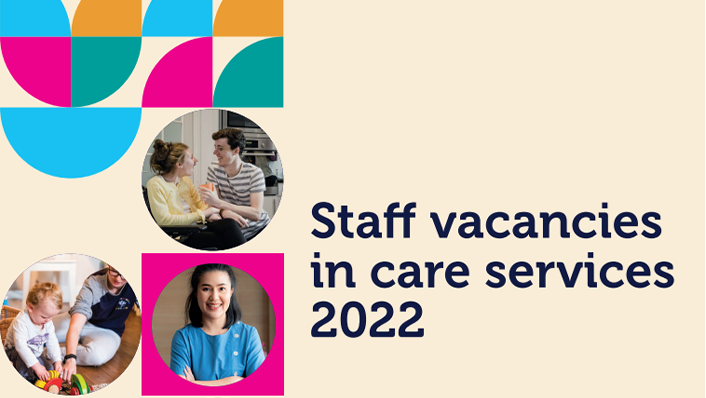The Staff vacancies in care services 2022 report provides data on vacancies reported by care services as at 31 December 2022. It shows the number of registered care services with a vacancy, the number of actual vacancies that services say they had using whole time equivalent (WTE) data and the reasons why services have reported that vacancies are hard to fill.
Key points
Staff vacancies
- The percentage of care services reporting vacancies increased to the highest level since we began publishing these statistics in 2017. At 31 December 2022, 49% of services reported having vacancies. The percentage of care services reporting vacancies increased by 2 percentage points over the last year.
- Care homes for older people, housing support services, care at home services, care homes for adults, care homes for children and young people, secure accommodation services and residential special school care accommodation services all had a proportion of services with vacancies significantly above the national average of 49% for all care services.
- East Dunbartonshire, Edinburgh, Dundee and North Lanarkshire local authority areas had a significantly higher proportion of services with vacancies than the national average of 49% for all care services.
- The rate of WTE vacancies for all services in Scotland was 8.7% up from 8.1% in 2021.
- Nurse agency services, care at home services and housing support services had a significantly higher rate of WTE vacancies than the national average of 8.7%.
Nursing vacancies
- 61% of services reported having nursing vacancies (where services employed nurses). This was an increase of 1 percentage point on the proportion of services with vacancies at 31 December 2021 (60%).
- The rate of WTE nursing vacancies for all services (where services employed nurses) in Scotland was 17.4%, up from 16.2% in 2021.
Problems filling vacancies and reasons given
- 63% of services with vacancies reported having problems filling them; up 5 percentage points from the previous year.
- Too few applicants in general (71%), too few applicants with experience (60%), and too few qualified applicants (51%) were the most common themes within most service types that reported problems filling vacancies.
Maree Allison, Acting Chief Executive of the SSSC said: ‘We work closely with the Care Inspectorate, Scottish Government and others to help employers recruit, retain and develop their staff, however this report shows the sector is experiencing more significant pressures than ever before and more needs to be done to attract and retain a workforce that feels valued and respected for the high quality care and support that workers deliver.
‘The report shows there are lots of job opportunities in care services and we are committed to promoting careers in care, supporting the need for fair work, terms and conditions and an effective workforce voice to help make care an attractive career choice.’
Jackie Irvine, Chief Executive of the Care Inspectorate, said: ‘The report highlights the extent of the current recruitment and retention challenges being faced by the sector at a time when services are experiencing continued pressure. Adult social care services are facing particular challenges with 76% of care homes for adults reporting vacancies, the highest since our reports began in 2017.
‘We remain grateful for the dedication and commitment of our skilled and qualified workforce during a time that remains challenging, and welcome the recent proposed increase to care workers’ salaries as one measure to help support the workforce.’
Read the Staff vacancies in care services 2022 report here.
